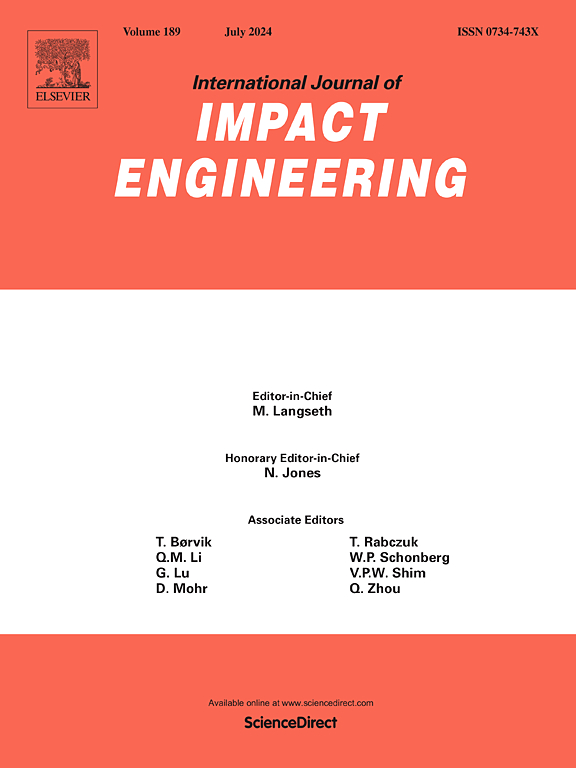爆炸荷载作用下钢结构动力响应的试验研究
IF 5.1
2区 工程技术
Q1 ENGINEERING, MECHANICAL
International Journal of Impact Engineering
Pub Date : 2025-05-26
DOI:10.1016/j.ijimpeng.2025.105389
引用次数: 0
摘要
研究结构在爆炸荷载作用下的动力响应一直是人们感兴趣的问题,特别是对于陆军、海军和任何国防基础设施而言。在结构的抗爆炸设计中,未能纳入适当的材料模型或忽略FSI效应可能导致结构响应的错误预测。该领域的实验研究主要集中在脉冲载荷和相关的结构响应上,只需最小的工作量,就能跨越td/tn的宽谱(td是爆炸载荷的持续时间,tn是结构的自然周期)。国际规范和结构抗爆炸设计的单自由度(SDOF)程序没有考虑到FSI效应,从而导致设计相当保守。为了解决上述差距,使用冲击波模拟器(BWS)在td/tn比(0.2至17)的大范围内进行了激波管实验,通过改变(a)样品厚度,(b)支撑/边界条件和(c)爆炸载荷强度等参数。实验观察表明,较低刚度的结构承受显著的变形,这减少了作用在结构上的载荷与较刚性的结构相比。实验结果与解析法的比较表明,解析法对峰值反射超压的预测过高,最大偏差达30%。实验结果与分析模型(或现行标准程序)在结构抗爆炸设计上存在显著差异。总的来说,这项研究强调了在结构的抗爆炸设计中结合FSI效应和现实材料建模的分析方法的重要性。本文章由计算机程序翻译,如有差异,请以英文原文为准。
Experimental study on the dynamic response of steel structure subjected to blast load
Studying the dynamic response of a structure subjected to a blast loading has always been of interest, especially for the army, navy and any defense infrastructure facilities. In the blast resistant design of a structure, failing to incorporate an appropriate material model or neglecting FSI effects can lead to an erroneous prediction of structural responses. Experimental studies in this area have primarily focused on impulse loading and the associated structural responses with minimal work spanning a broad spectrum of the ratios ( is the duration of the blast load, and is the natural period of the structure). International codes and the Single Degree of Freedom (SDOF) procedure on blast resistant design of structures do not account for the FSI effects, thereby resulting in a considerably conservative design. To address the above gaps, shock tube experiments using Blast Wave Simulators (BWS) are conducted across a wide range of ratios (0.2 to 17), by varying the parameters such as (a) sample thickness, (b) support/boundary conditions and (c) blast load intensity. Experimental observations reveal that less-stiff structures undergo significant deformation, which reduces the load acting on the structure compared to more-stiff structures. Comparing the experimental results with the analytical approach shows that the peak-reflected overpressure is overpredicted in the analytical approach with a maximum difference of 30 %. It is also found that there is a significant difference between the experimental results and the analytical model (or) the existing standard procedure on the blast resistant design of the structure. Overall, this study highlights the importance of incorporating FSI effects and an analytical approach with realistic material modeling in the blast resistant design of structures.
求助全文
通过发布文献求助,成功后即可免费获取论文全文。
去求助
来源期刊

International Journal of Impact Engineering
工程技术-工程:机械
CiteScore
8.70
自引率
13.70%
发文量
241
审稿时长
52 days
期刊介绍:
The International Journal of Impact Engineering, established in 1983 publishes original research findings related to the response of structures, components and materials subjected to impact, blast and high-rate loading. Areas relevant to the journal encompass the following general topics and those associated with them:
-Behaviour and failure of structures and materials under impact and blast loading
-Systems for protection and absorption of impact and blast loading
-Terminal ballistics
-Dynamic behaviour and failure of materials including plasticity and fracture
-Stress waves
-Structural crashworthiness
-High-rate mechanical and forming processes
-Impact, blast and high-rate loading/measurement techniques and their applications
 求助内容:
求助内容: 应助结果提醒方式:
应助结果提醒方式:


